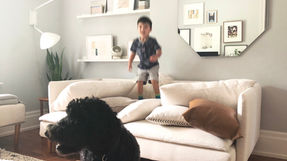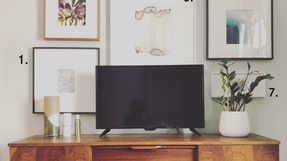...Or, How to Reclaim A Stylish, Organized Home (After Kids)

Our Living Room.
This post contains affiliate links. See disclosure.
Along with traveling and a trip to the grocery store, achieving and maintaining a stylish, organized home is one of those things that is just more difficult with kids. Decluttering is hard enough with your own belongings, but throw kids into the mix and you've got just so much more to sort through and organize! (For more on roadblocks to keeping a tidy home when you have kids and how to overcome them, click here to check out my guest post on Motherhood Creation).
In this post, I'll share the decluttering and organizational strategies that worked for us and helped us to reclaim our home after kids.
Before my son was born in 2014, my husband and I took for granted that our home would always look the way we wanted and reflect our taste and personalities. Then came the baby shower followed precipitously by my son's birth. Suddenly, we were inundated with onesies, stuffed toys, and breastfeeding paraphernalia.
For months after he was born, our living room was cloaked in multicoloured playthings and our previously placid Mid-Century Modern/Scandinavian aesthetic was unrecognizable.
Then I came across The Life Changing Magic of Tidying Up by Marie Kondo, which was just starting to develop a cult following.
It was a quick, easy read that had me inspired to declutter with its seductive mantra of holding on to only those things that 'spark joy'. We didn't actually purge to that extent and have definitely not adopted a minimalist lifestyle. But, it served as an effective call to action.
I found early in the process that decluttering is profoundly more difficult when you have kids. You're starting out with the disadvantage of more stuff. So...much...more...stuff.
Through trial and error, we've come up with a series of steps that work for us when it comes to decluttering kids' stuff:
1. The Purge
Go through your kids' current belongings and put aside any broken, outgrown and seldom-played-with items to give away/donate/sell/throw out.

The round up from our most recent purge.
Depending on how old your kids are and how much you've accumulated, this may take some time. You can decide for yourself how far to go with the purge; it may involve getting rid of half-a-dozen things or half of all the stuff.
If your kids are old enough, involve them in the process. It's never too early to learn how not to be a hoarder!
2. Designate a Central Repository for Toys
Once you've pared down the playthings, decide on a central place (or two) to confine them. This can be the kids' room, playroom, basement or combination of these. Our central repository resides primarily in the basement, and to a lesser extent, my son's bedroom.

Open shelving in the basement allows for bins to be withdrawn and returned easily.
3. Develop a Storage System for Toys (i.e. bins, drawers)
Once you've decided on where, select how you would like to store toys in this area. We've found that clear bins on open shelving in our basement work well, as the contents of the bins are easily seen and accessible.
These are the shelves and bins we used:
If your kids have a lot of small toys with tiny parts, having some smaller bins may come in handy:
For each bin, we grouped items in loosely related categories. For us, these include: Art Supplies, Cleaning Toys (gotta start 'em young!), Toy Instruments, Train Tracks, Games, Puzzles, Toy Cars/Hot Wheels, Stuffed Toys, Large Trucks, Toy Tools, Action Figures and LEGOs.

While I would start with a framework like this, I've found from experience that you get more play-per-bin if you loosen the reigns a little and allow intermingling of several unrelated, but complimentary toys. (As I write this, my son's playing with his 'Big Trucks' bin, which also includes a few action figures tossed in to serve as passengers for the trucks).
When storing the bins within your shelving system, think of functionality. We store bins containing his most requested toys on the lowest, most easily accessible spots on the shelf.

Trucks are my son's favorite. He can help himself to these when he accompanies me on a laundry trip to the basement.
We keep less requested items, and things we don't want him getting into without supervision, at the top.

Paint, glue and other hazards to our home are well out of our kiddo's reach on the top shelf.
In my son's room (our secondary toy repository), we keep all of his books and just a few drawer's worth of toys. At his bedside, an IKEA Stuva bench and drawer combination serve as a bedside table with ample storage and keeps books at arms reach for bedtime.
IKEA Stuva bench and drawer.
Two of these IKEA Slakting boxes fit perfectly into the Stuva bench/drawer combination, as pictured above.
Another IKEA Stuva drawer combination houses more books, with two drawers for his favorite, most frequently played with toys.
I love the IKEA Stuva System for a kid's room. It's modular/customizable, so you can add and rearrange pieces as your kid grows.
We used an assortment of these versatile IKEA SKUBB boxes to compartmentalize the toy drawers.
If you prefer open shelving for the bedroom or playroom, something like this might work well:
4. Common Areas Should be 'No Parking' Zones for Toys
To keep your common areas tidy, they should be 'no parking' zones for toys (in plain sight, at least).

Our living room. At first glance, you can't tell a kid lives here!
Allow for just one bin to be out of the central repository and in the common area at a time. If your kid requests a toy from another bin, return the current play bin to its place before bringing another bin out.
Once playtime is over (and this may not be until the end of the day), toys must go back into the bin. You can put your kids in charge of 'tidy up time.' The bin should then either be returned to the basement (or wherever your central repository is housed) or stowed somewhere relatively out of sight.
What has worked well for us is having a temporary (and out-of-sight) resting place for the current play bin in the living room. For us, this is the area behind the baby gate that blocks off the basement staircase (we have another, unobstructed basement entry at the back of the house). Other areas that may work are a corner of the pantry or mudroom that is adjacent to your common area.
5. Have Secret Hiding Spots For Toys in Your Living Room
A large basket covered with a throw serves to conceal toys in our living room.
Carve out convenient, but inconspicuous, places to conceal a select few toys within common areas. While designating a central repository for toys really helps to cut down on clutter, no one gave your kid the memo that his stuff ruins the aesthetic of the living room, and could he please refrain from leaving it there???
Alas, it's impossible to keep100% of toys in the kids' room or basement while maintaining your sanity.
It makes sense to build in some hidden storage for a select few toys and as a contingency plan for toys that don't make it back to their designated bins. (See this post for more on how to inconspicuously store kids' stuff in your common areas).
6. Control What Comes In
Once you've completed the hard work of purging and organizing, make sure you protect what you've accomplished.
Part of this involves reducing the sheer volume of what comes in. Think about quality over quantity; instead of a weekly trip to the dollar store for cheap knickknacks, try saving up for one monthly (or semi-annual) high quality toy. (I'll be honest and admit that this is one bad habit I'm still trying to kick). Or, consider rewarding your kids with experiences (trips to the science centre, indoor playgrounds etc.) instead of things.
When it comes down to choosing a toy for your kids, think about the visual impact it will have on your home.We strive for a clean, somewhat minimal aesthetic, so we lean towards toys that compliment that. Hape makes some well-crafted toys that are easy on the eyes:
It also helps to choose toys that are self-contained and come with their own storage solution:

Also, toys that have multiple features, or act as more than one type of toy, make great space savers.
It also helps if you let your friends and family know what you're trying to achieve. Send out a wish list of clothing and preferred toys at birthdays and Christmas. We have started doing this and it has cut down immensely on the influx of unwelcome toys.
7. Keep Editing
Decluttering is an ongoing process. Periodically go through your kids' toys and remove from the rotation any that are broken, outgrown, or redundant.
Keep your kids involved, because it's never too early to teach hoarding prevention. This past year, just before my son's third birthday, we asked him to pick out several toys he would consider 'too baby-ish' for him to give away or donate, in order to make room for all of the new things he would be getting for his birthday. We did the same before Christmas, and hope to continue with this.

I hope this was helpful for anyone looking to declutter their kids' stuff and reclaim an organized home after kids! Please click below to like/pin/tweet.
Let me know if you have any questions or share what's worked for you in the comments below! If you want alerts when you posts like this one are available, please subscribe.












































